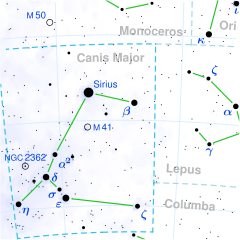Delta Canis Majoris
| Observation data Epoch J2000 Equinox J2000 | |
|---|---|
| Constellation | Canis Major |
| Right ascension | 07h 08m 23.48608s[1] |
| Declination | −26° 23′ 35.5474″[1] |
| Apparent magnitude (V) | 1.824[2] |
| Characteristics | |
| Spectral type | F8 Ia[3] |
| U−B color index | +0.584[2] |
| B−V color index | +0.67[4][5] |
| Variable type | ?[6] |
| Absolute magnitude (MV) | –5.97[4] |
| Details | |
Myr | |
HR 2693, SAO 173047. | |
| Database references | |
| SIMBAD | data |
Delta Canis Majoris (
Observation
Delta Canis Majoris is the third-brightest star in the constellation after Sirius and ε Canis Majoris (Adhara), with an apparent magnitude of +1.83, and is white or yellow-white in colour. Lying about 10 degrees south southeast of Sirius, it only rises to about 11 degrees above the horizon at the latitude of the United Kingdom.[14] The open cluster NGC 2354 is located only 1.3 degrees east of Delta Canis Majoris.[15] As with the rest of Canis Major, Delta Canis Majoris is most visible in winter skies in the northern hemisphere, and summer skies in the southern. In Bayer's Uranometria, it is in the Great Dog's hind quarter.[16]
History and naming
δ Canis Majoris (Latinised to Delta Canis Majoris) is the star's Bayer designation.
The traditional name, Wezen (alternatively Wesen, or Wezea), is derived from the medieval Arabic وزن al-wazn, which means 'weight' in modern
In 2016, the International Astronomical Union organized a Working Group on Star Names (WGSN)[19] to catalog and standardize proper names for stars. The WGSN's first bulletin of July 2016[20] included a table of the first two batches of names approved by the WGSN; which included Wezen for this star.
In Chinese, 弧矢 (Hú Shǐ), meaning Bow and Arrow,[21] refers to an asterism consisting of δ Canis Majoris, ε Canis Majoris, η Canis Majoris, κ Canis Majoris, ο Puppis, π Puppis, χ Puppis, c Puppis and k Puppis. Consequently, δ Canis Majoris itself is known as 弧矢一 (Hú Shǐ yī, English: the First Star of Bow and Arrow.)[22]
In the catalogue of stars in the Calendarium of Al Achsasi Al Mouakket, this star was designated Thalath al Adzari (تالت ألعذاري - taalit al-aðārii), which was translated into Latin as Tertia Virginum, meaning the third virgin.[23] This star, along with ε Canis Majoris (Adhara), η Canis Majoris (Aludra) and ο2 Canis Majoris (Thanih al Adzari), were Al ʽAdhārā (ألعذاري), the Virgins.[24][25]
Physical properties

Delta Canis Majoris is a supergiant of class F8. Its surface temperature is around 5,818 K,[26] and it is 14 times more massive than the Sun.[8] Its absolute magnitude is −5.97,[4] and it lies around 1,600 light-years away. It is rotating at a speed of around 28 km/s, and hence may take a year to rotate fully. Only around 10 million years old, Delta Canis Majoris has stopped fusing hydrogen in its core. Its outer envelope is beginning to expand and cool, and in the next 100,000 years it will become a red supergiant as its core fuses heavier and heavier elements. Once it has an iron core, it will collapse and explode as a supernova.[18]
The
If Delta Canis Majoris were as close to Earth as Sirius is, it would be as bright as a half-full moon.[28]
Modern legacy
Delta Canis Majoris appears on the flag of Brazil, symbolising the state of Roraima.[29]
Notes
- ^ Applying the Stefan–Boltzmann law with a nominal solar effective temperature of 5,772 K:
- .
References
- ^ S2CID 18759600.
- ^ Bibcode:1966PDAUC...1....1G.
- S2CID 119096173.
- ^ at VizieR.
- ^ .
- S2CID 10505995.
- Bibcode:1967IAUS...30...57E.
- ^ ISSN 1365-2966
- ^ .
- ^ ISSN 0004-6337.in VizieR.
{{cite journal}}: CS1 maint: multiple names: authors list (link) Delta Canis Majoris' database entry - Bibcode:2003RMxAA..39....3A.
- ^ "IAU Catalog of Star Names". Retrieved 28 July 2016.
- Bibcode:1993AAS...183.1710G. Archived from the originalon 2019-06-25. Retrieved 2012-02-04.
- ISBN 978-1-4419-0325-9.
- ^ "Canis Major".
- ^ ISBN 0-486-21079-0.
- ISBN 978-1-931559-44-7.
- ^ a b Kaler, James B. "Wezen". Stars website. University of Illinois. Retrieved 28 May 2010.
- ^ "IAU Working Group on Star Names (WGSN)". Retrieved 22 May 2016.
- ^ "Bulletin of the IAU Working Group on Star Names, No. 1" (PDF). Retrieved 28 July 2016.
- ^ 弧矢 (Hú Shǐ) is westernized into Koo She. R.H. Allen had opinion that Koo She refers to the asterism including δ Velorum and ω Velorum. AEEA opinion is, δ Velorum is member of 天社 (Tiān Shè), meaning Celestial Earth God's Temple asterism and ω Velorum is not member of any asterisms. 天社 (Tiān Shè) is westernized into Tseen She and R.H.Allen used the term Tseen She for Chinese name of η Carinae. See Richard Hinckley Allen: Star Names — Their Lore and Meaning: Argo Navis and (in Chinese) AEEA (Activities of Exhibition and Education in Astronomy) 天文教育資訊網 2006 年 7 月 17 日.
- ^ (in Chinese) AEEA (Activities of Exhibition and Education in Astronomy) 天文教育資訊網 2006 年 7 月 17 日
- .
- ISBN 0-486-21079-0. Retrieved 2010-12-12.
- ^ ε CMa as Aoul al Adzari or Prima Virginum (the first virgin), ο2 CMa as Thanih al Adzari or Secunda Virginum (the second virgin) and δ CMa as Thalath al Adzari or Tertia Virginum (the third virgin). η CMa should be Rabah al Adzari or Quarta Virginum (the fourth virgin) consistently, but it was given by the name Aludra, meaning 'the virgin' (same meaning with Adhara (ε CMa) or Al ʽAdhārā)
- ^ S2CID 9095731.
- ISBN 978-3-540-29692-8. The radius (R*) is given by:
- ISBN 0-521-53306-6.
- ^ "Astronomy of the Brazilian Flag". FOTW Flags Of The World website.



